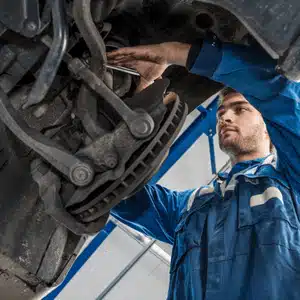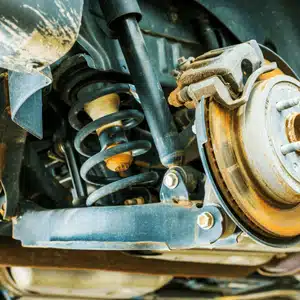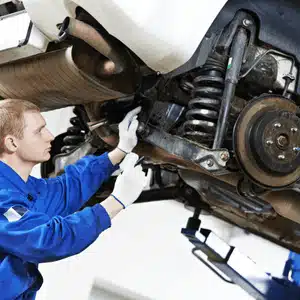Weekdays 8:00am-5:00pm Sat Closed Sun Closed

Land Rover vehicles deliver exceptional ride quality and dynamic capability across all terrains. From the rugged Defender to the luxurious Range Rover, these SUVs earn their reputation through sophisticated air suspension systems that adapt to any driving condition.
For Land Rover owners in Texas, where highways stretch for miles and off-road trails test every vehicle component, understanding your suspension becomes critical. Hot summers, varied terrain, and daily driving all challenge these advanced technology systems.
This guide explores how Land Rover suspension works, common issues across models, and maintenance practices that keep your SUV performing as the manufacturer intended.

Modern Land Rovers use Electronic Air Suspension instead of traditional coil springs. This intelligent system relies on air springs at each of the four corners, controlled by an onboard compressor and electronic management.
The system constantly monitors ride height through sensors and adjusts air pressure to maintain level stance. Range Rover models can raise nearly three inches for off-road adventures or lower for improved aerodynamics on highways.
Terrain Response integrates with the suspension to optimize settings automatically. When the system detects mud or sand, it raises ride height and adjusts traction control for maximum grip. The latest Terrain Response 2 can sense surface conditions and respond without driver input.
Adaptive Dynamics represents the pinnacle of suspension technology. This system monitors vehicle movement 500 times per second, adjusting dampers instantly to minimize body roll and optimize comfort. The result delivers supreme ride comfort while maintaining precise driving dynamics.
Active anti-roll bars work with Adaptive Dynamics to reduce lean in corners. These electronic systems can apply over 1,000 lb-ft of torque to counteract body movement, keeping the vehicle flat through turns.
Torque vectoring by braking enhances this capability further. By selectively applying brakes to inside wheels during cornering, the system improves stability and driver confidence on any surface.

Proper suspension maintenance affects every aspect of your Land Rover experience. The system keeps tires in contact with the road, ensuring safety and performance meet expected standards.
Safety comes first. Worn suspension components compromise stability and increase braking distances. In a tall, heavy SUV, these issues become magnified. The suspension must respond effectively for systems like ABS and traction control to work properly.
Ride comfort defines the Land Rover experience. When springs lose pressure or dampers wear out, that magic-carpet ride quality disappears. Even minor degradation transforms smooth highways into jarring experiences for occupants.
Off-road performance depends entirely on suspension function. Texas drivers who explore ranch trails or beach sand need full ground clearance and wheel articulation. A failing air suspension system reduces capability and confidence when you venture off pavement.
Ignoring suspension problems creates secondary damage. Uneven ride height causes premature tire wear. Overworked compressors from small leaks eventually fail completely. What starts as an affordable repair becomes expensive when multiple components need replacement.
Texas conditions add unique challenges. Summer heat accelerates rubber deterioration in springs and seals. Construction zones and rough roads fatigue components faster. Many specialists recommend more frequent inspections for vehicles in Texas climates.
Land Rovers communicate suspension issues through clear warning signs. Modern vehicles monitor system performance constantly and alert drivers when problems develop.
Dashboard warnings appear first. Suspension fault messages indicate the system detected pressure loss or sensor problems. Don't ignore these alerts - they prevent more serious failures.
Visual inspection reveals obvious problems. Vehicle sagging on one side or sitting lower after parking suggests air spring leaks. Uneven stance means air isn't reaching all corners equally.
Taking longer to raise ride height indicates system strain. Healthy compressors lift vehicles within seconds. Extended raise times or constant compressor cycling suggests leaks forcing the system to work harder.
Ride comfort changes signal component wear. If your Land Rover feels harsh over bumps or bounces excessively, springs or dampers may be failing. The bounce test helps identify weak corners - press down firmly and watch how quickly the vehicle settles.
Excessive nosedive during braking or squat under acceleration shows suspension softness. Weight transfer is normal, but dramatic movement indicates worn components affecting safety.
Strange noises from the undercarriage point to mechanical wear. Clunks over bumps often mean worn bushings or sway bar links. These frequently occur as rubber components age and crack.
Understanding failure causes helps prevent problems. Air suspension systems have predictable weak points that develop over time, especially on luxury models like the Range Rover which includes advanced suspension features across its USA dealer network.

Natural wear affects all components. Air springs flex constantly, and exposure to elements causes rubber to crack. Most systems, including those in a Range Rover, develop leaks between 60,000 to 100,000 miles, depending on climate, number of occupants, and road conditions. Always follow manufacturer guidelines for inspection.
Leaks start small but grow quickly. Sharp debris can puncture springs, while stress points at folds and connections frequently fail. Even tiny leaks force compressors to run more often, eventually causing overheating. On a Range Rover, this can trigger unwanted lowering or system warnings that indicate an emergency exit strategy is needed. Refer to your Range Rover manual or official website for troubleshooting steps. Monitoring your Range Rover’s suspension features helps limit repairs and extend the system’s life.
Compressor overload happens when air suspension systems fight leaks. The compressor makes pressure to fill air springs. If air escapes faster than replacement, the unit runs continuously. Overworked compressors overheat and seize, requiring expensive replacement. In a Range Rover, this affects driving dynamics, performance, and overall vehicle capability.
Overloading beyond manufacturer limits stresses all components. Heavy towing or cargo loads can rupture springs or accelerate wear. In Range Rover models, exceeding these limits can disrupt air suspension, adaptive dynamics, and increase unsprung mass, impacting lateral acceleration and safety. Always respect weight ratings and towing capacity to preserve air suspension function.
Environmental factors affect air suspension life. Dust clogs filters and contaminates moving parts. Road salt corrodes metal components. Heat dries rubber seals and bushings faster than normal. This is especially critical in Range Rover vehicles that rely on terrain response systems and precise wheel control for off-road capability.
Ignoring early warnings allows problems to multiply. Small leaks become major failures when left unaddressed. Warning lights exist for good reason—addressing issues early prevents expensive repairs. Range Rover’s air suspension systems include built-in alerts through terrain response settings. Reacting early protects your vehicle and ensures your air suspension operates safely across every wheel and surface.
Regular suspension care keeps your Range Rover performing optimally. These practices deliver reliable stability and prevent unexpected failures in any driving terrain response setting.
Schedule annual inspections, especially after 60,000 miles. Professional testing includes leak checks, ride height calibration, and diagnostic scans tailored for Range Rover air suspension systems. Early detection saves money and prevents roadside failures. Keeping track of the number of services completed ensures ongoing vehicle stability and control.
Wash undercarriage areas gently after off-road use to remove mud and debris. Clean compressor intake areas prevent clogs that reduce efficiency. This is especially important for Range Rover models, where air suspension components affect ride dynamics, load capacity, and control on any wheel. Mud buildup can push components beyond normal wear, affecting long-term stability.
Suspension bushings typically need replacement around 80,000 miles. Worn components create stress on other parts and affect ride quality. In a Range Rover, bushings also impact air suspension, control, and dynamics across all four wheels. Replace them before they push the system too far. Across the market, Range Rover sets a high bar in car luxury, but maintaining control and stability helps retain its value in the world of premium vehicles.
Land Rover releases updates that improve system performance and address known issues. These updates often enhance features like air suspension response and load management. Proper calibration after repairs ensures all systems work together correctly in your Range Rover, maintaining manufacturer standards.
Always engage jack mode before lifting to prevent spring damage. Trust experienced Range Rover technicians who understand these complex systems and follow manufacturer guidelines. Improper lifting can stress the air suspension and affect features like adaptive ride height or load leveling.
Pay attention to ride height consistency, compressor run time, and ride comfort changes. These can signal problems with your Range Rover’s air suspension. Early intervention prevents major failures and protects important features like load distribution and stability. Routine testing ensures everything functions effectively and matches manufacturer expectations.
Document the number of software updates, service visits, and any system alerts. Monitoring the number of incidents helps identify trends before they become expensive problems. Across the market, Range Rover continues to lead in luxury SUV features, but proper care is key.
Keep track of the number of off-road trips and heavy load conditions to maintain optimal performance. Regular testing and software updates keep your Range Rover running at its best. A well-maintained Range Rover maximizes comfort and system features throughout its lifespan.

Suspension systems require specialized knowledge and equipment. Not all shops have the tools or training to service these advanced technology systems properly, especially on a Range Rover.
Diagnostic equipment specific to Range Rover vehicles reads fault codes and calibrates ride height accurately. Generic scan tools miss important data these systems make. Without proper testing, even minor issues can push the system into failure.
Genuine parts ensure proper fit and performance. While aftermarket options exist, OEM components match original specifications exactly. Using non-OEM parts in a Range Rover may reduce longevity and interfere with system integration. Quality parts last longer and work better with existing systems across the Range Rover lineup.
Proper calibration after repairs ensures all systems communicate correctly. Range Rover features like Adaptive Dynamics, Terrain Response, and traction control must recognize new components to function properly. Skipping this step can increase the number of system errors.
Experienced technicians understand how suspension integrates with multiple Range Rover systems. Correct repairs require attention to these connections to avoid future complications. With so many interconnected systems in a Range Rover, even small oversights can push related systems out of sync.
A well-serviced Range Rover car maintains peak performance. Always track the number of service events and rely on trained professionals familiar with Range Rover systems and testing protocols.
Your Range Rover represents a significant purchase decision. Proper suspension maintenance in Land Rover protects that investment while ensuring continued performance unique to the Range Rover name.
Regular care extends component life significantly. Proactive Range Rover owners often enjoy trouble-free operation well past 100,000 miles. The key lies in addressing issues before they cascade into major problems, especially within the sophisticated systems of your Range Rover.
Quality maintenance pays dividends in comfort and capability. A well-maintained suspension delivers the supreme ride comfort and go-anywhere confidence that defines the Range Rover experience. Whether navigating urban streets or rugged trails, your Range Rover is engineered to excel.
Range Rover customers who prioritize suspension care report higher satisfaction with their vehicles. Smooth operation on road and trail keeps the driving experience enjoyable year after year. Protecting the unique capabilities of your Range Rover begins with understanding its technology and staying ahead of wear.
A well-cared-for Range Rover maintains its luxury feel and exceptional control across all terrain. Suspension upkeep is central to maintaining refinement. Whether you use your Range Rover for everyday commuting or outdoor adventure, regular suspension checks are essential. Invest in your Range Rover and enjoy its legendary performance for years to come.
If your Land Rover shows any suspension warning signs, schedule professional inspection promptly. Qualified service centers can diagnose problems accurately and recommend appropriate solutions.
Don't wait for complete Land Rover failure. Small issues caught early cost far less than major repairs. Your safety depend on properly functioning suspension components.
Invest in regular maintenance to deliver continued performance. Your Land Rover was developed to handle any terrain with confidence - proper suspension care ensures it always can.
Whether exploring Texas backroads or navigating city traffic, your suspension makes every journey comfortable and capable. Take care of it, and it will take care of you for many miles ahead.

